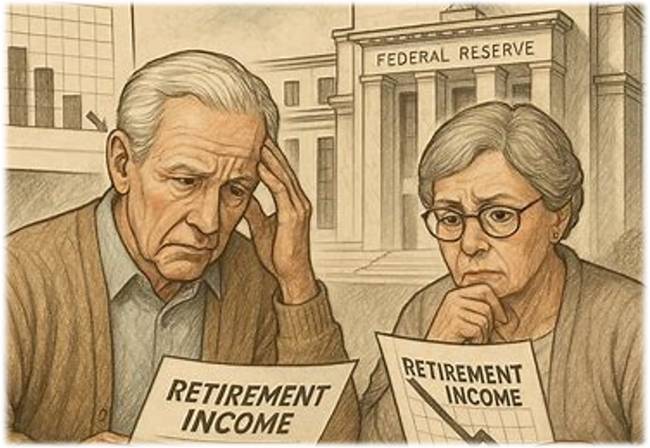Fed Rate Cuts Threaten Retirees’ Financial Security
Disclaimer: This article is for informational purposes only and does not constitute financial advice. Consult a qualified professional for personalized guidance.
By Doug Young – 29 August 2025
Introduction
As the Federal Reserve signals potential interest rate cuts in late 2025, retirees face significant financial challenges ahead.
While such moves often aim to stimulate economic growth, their impact on retirees—who commonly rely on fixed incomes and interest-bearing savings—can be profound.
This article explores why Fed rate cuts may threaten the financial security of America’s retirees, emphasizing the importance of understanding macroeconomic effects beyond market headlines.
Background on Federal Reserve Rate Cuts
The Federal Reserve cuts interest rates to encourage borrowing, business investment, and consumer spending when economic momentum slows.
After a series of hikes between 2022 and 2023 to combat historic inflation rates, the Fed is expected to reduce rates beginning with a quarter-point cut likely in September 2025, followed by additional cuts through the end of the year.
These moves respond to signs of labor market softening and modest easing in inflationary pressures, although uncertainties remain as the Fed balances growth with inflation control.
Impact on Retirees’ Fixed Income
Retirees are particularly vulnerable to rate cuts because most rely on income generated from interest-bearing accounts such as certificates of deposit (CDs), bonds, and savings accounts.
When the Fed lowers rates, yields on these conservative investments typically fall, shrinking retirees’ income streams. For example, if inflation runs at 3% and a CD yield drops from 4% to 3.25%, a retiree’s real income after inflation can decline sharply.
This often forces them to withdraw from their principal savings to cover living expenses—a practice that erodes their financial safety net over time.
Inflation and Currency Risks
Although the Fed uses rate cuts to support the economy, there is a risk these policies could weaken the U.S. dollar and allow inflation to persist.
Historical episodes in countries like Turkey and Argentina show how aggressive monetary easing can lead to currency depreciation and soaring consumer prices.
The U.S. experienced similar challenges in the 1970s when runaway inflation severely impaired retirees’ purchasing power. While Fed Chair Paul Volcker once restored balance with decisive rate hikes, today’s retirees risk similar real income erosion if inflation remains sticky despite rate cuts.
Demographic and Economic Pressures
Underlying these monetary policy challenges are demographic shifts: by 2034, older adults are projected to outnumber children in the U.S.
This growing retiree population will increase demand for stable income sources, while simultaneously straining public budgets as infrastructure and social services require significant funding.
These combined pressures create an environment where inflation may stay relatively high and interest rates remain a delicate balancing act.
How Rate Cuts Affect Borrowers and Consumers Differently
While lower rates may reduce borrowing costs—potentially benefiting retirees with mortgages or other debt—they disproportionately impact those depending on interest income.
Mortgage and loan rates do not always immediately decline in tandem with Fed cuts due to complex market factors, so the improvements in borrowing expenses may be gradual or muted.
Meanwhile, savings yields tend to adjust down faster and more broadly, creating a double-edged sword situation for retirees balancing debt and income needs.
Alternatives and Protective Strategies (Non-Investment Focus)
In light of these risks, retirees are advised to regularly review their overall financial plans and income sources—without necessarily chasing specific investment advice.
Educationally, diversifying income streams and understanding exposure to inflation and interest rate changes are prudent steps.
Historically, certain assets like inflation-protected securities or commodities have served as hedges against declining purchasing power, though any consideration of such options should be carefully researched and discussed with qualified advisors.
What Retirees Should Monitor Moving Forward
Retirees should stay informed of key economic indicators such as inflation reports, employment data, and Federal Reserve announcements.
These signals can provide insight into the broader economic environment and potential shifts in monetary policy.
Remaining cautious of sudden market shifts and seeking periodic professional financial guidance can help retirees navigate a landscape of evolving rates and inflation pressures.
Conclusion
Federal Reserve rate cuts in 2025 may pose substantial risks to retirees’ financial security, particularly through reduced income and sustained inflationary challenges.
Awareness of these macroeconomic dynamics, combined with proactive financial review, is essential for retirement stability.
While the Fed’s moves intend to bolster economic growth, understanding the nuanced effects on fixed-income retirees helps clarify the challenges and the need for vigilance in retirement planning.
Disclaimer: This article is for informational purposes only and does not constitute financial advice. Consult a qualified professional for personalized guidance.









